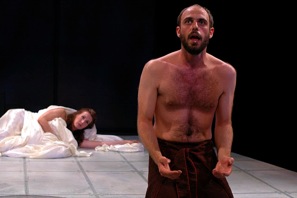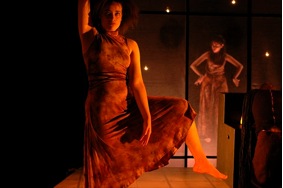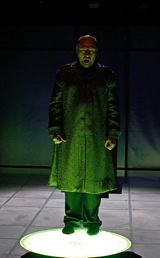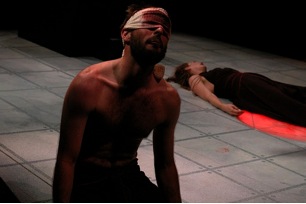Oedipus
by Seneca
Translated and adapted by Ted Hughes
Directed by Matthew Moore
July 28 - August 14, 2011
Stanford Summer Theater
Nitery Theater, Stanford University
Review by David J. Jacobson
University of California, Berkeley

Matt DiBiasio as Oedipus and Courtney Walsh as Jocasta.
Photo courtesy of Stanford Drama.

Leigh Marshall (front) and Sukanya Chakrabarti (performing hand-dance) as Chorus members; Matt DiBiasio as Oedipus.
Photo courtesy of Stanford Drama.

Thomas Freeland as Laius.
Photo courtesy of Stanford Drama.

Matt DiBiasio as Oedipus and Courtney Walsh as Jocasta.
Photo courtesy of Stanford Drama.
For the concluding play of Stanford Summer Theater’s thirteenth season, the Memory Play Festival, Artistic Director Rush Rehm selected Ted Hughes’s translation and adaptation of Seneca’s Oedipus. The National Theatre in London commissioned Hughes in 1968 as a last-minute replacement for David Turner, whose translation director Peter Brook found unsuitable to his vision of the production. Within a few weeks Hughes delivered a raw, visceral script, stripped of the original’s lengthy rhetorical speeches, references to divinities, and elaborate metrical structures (elements that Hughes believed had not stood the test of time), but brilliantly capturing the essence of Seneca’s play.
Hughes’s Oedipus, like Seneca’s, spotlights the verbal, poetic arts at the expense of more dramatic qualities. Director Matthew Moore’s Oedipus manages to redress the balance through the carefully planned use of space, music, dance, and acting that complements the power of Hughes’s poetry. The Stanford Oedipus was played in an intimate black-box theater on a slightly raised trapezoidal stage with an illuminable circle downstage at center. Large aisles flanked the stage, providing ample room for entrances and exits, as well as an unobtrusive space for the chorus to sit when they were not directly engaged with the action. Stage right led to the city center of Thebes, stage left into the palace. Above the stage were small pendant lights, which lent a nocturnal air to the play. And while this illumination stood in tension with the chorus’s opening words (“night is finished”), it elegantly represented the “reluctant” sun whose “sickly daylight” was filtered through the cloud of plague.
On entering the theater, the audience saw the stage covered with a white satin sheet; Thebes was presented as a bed. There was no throne yet, just two black blocks situated behind the stage. During the first two acts these were moved onstage, sat or stood upon by various characters, until finally, by the end of Act Two, a rudimentary throne had been formed upstage. In Act Four, the throne’s arms were attached as Oedipus learned who his real mother is. The symbol of Oedipus’s royal authority gradually took shape before our eyes, but its complete form was bitterly ironic and short-lived.
The palace façade was a scrim employed sparingly to good effect. The play opened with the Sphinx, ominously silhouetted, wings outstretched. Her voice, like Creon’s during his ventriloquism of Laius in Act Three, was given an otherworldly timbre with the aid of a microphone as she roared her programmatic riddle:
show us
show us
a simple riddle lift everything aside
show us
a childish riddle
what has four legs at dawn
two legs at noon three legs at dusk
and is it weakest when it has the most?
‘I will find the answer’ is that an answer?
show us
The metatheatricality of the repeated “show us” was nicely underscored by the chorus’s whispered echo of the final utterance. Indeed, we were shown. The scrim’s second use came at the close of Act Three. As the chorus danced and chanted their ode downstage and Oedipus crouched against his throne upstage, with his back to the audience for the first time, one of the chorus members (Sukanya Chakrabarti, who also played Phorbas) performed an elegant Indian hand dance. The blocking here focused attention simultaneously on the ruler whose control was slipping away and on the motif of hands (used visually throughout this production—Oedipus was seen often methodically rubbing his arms from his biceps down to his fingertips, as if they were itching to do something), foreshadowing the moment when his fingers will finally tear his eyeballs from their sockets. The best use of the scrim, however, occurred at the end of Act Four. Jocasta, having failed to persuade her husband-son to stop seeking the truth, slinked offstage. As Oedipus continued to press Phorbas for information about his birth, we saw Jocasta behind the scrim. At times she covered her face with her dress and put her hands on her head or her face. Her pain was palpable. The staging here implored the audience to recall Sophocles’ Oedipus and to interpret Jocasta’s silent exit, visible despondency, and her actions behind the scrim as portents of the queen’s imminent suicide. But this is Seneca, not Sophocles, and the audience’s partial recollection of how things are “supposed” to unfold effectively echoes the imperfect memories and (mis)recollections of past events by characters within the play.
Spatially, the stage comprised two semidistinct places: downstage was associated with Thebes at large, while upstage, which represented the palace and the area immediately before it, was closely tied to the inner workings of the city’s politics. The interconnectivity between these two spaces, growing as the play progressed and the characters (Oedipus and Jocasta in particular) moved more freely up and down the stage, was neatly presaged by the drama’s opening scene, in which a shirtless, bearded Oedipus clad in dark, red-trimmed trousers entered from the door that admitted the audience. He confidently told the Sphinx “I will find the answer,” and then approached Jocasta, who, now visible beneath the sheet, beckoned him seductively with a gentle flip of the fabric. They embraced, enveloped each other in the sheet, and lay together. The incestuous union covertly enacted before us upstage soon spilled over onto the rest of the stage as Oedipus and Jocasta moved forward and discussed the role of kingship. Thus the cause of the plague (shown upstage) and its effects on the rest of the city (downstage) were concisely presented. Throughout the play, but especially during the union of Oedipus and Jocasta, the music of Michael St. Clair facilitated a deeper engagement with the events onstage. His original compositions, prerecorded and played over a sound system, used a range of tonalities to augment (and sometimes even generate) the emotional tenor of each scene.
Occasionally I found the staging distracting. One challenge facing all directors of this play is how to get Oedipus’s sword onstage. In this production the Slave places it on the throne before delivering his messenger speech. While this staging is not without precedent, it is awkward at best, leaving us wondering why he had the sword to begin with and why he placed it where he did. I would have preferred Oedipus to wear the sword from the beginning or to be equipped with it at some point during the play, perhaps at the end of Act One as he assumes his kingly garb during the choral ode. Twice I found the blocking at odds with the verses. At the opening of Act Two, Oedipus stood at the front of the stage, looking at the audience as he announced Creon’s entrance, but Creon entered from the stage-right aisle behind Oedipus and therefore could not be seen by the king. The other instance occurred during the extispicy scene as Manto (Beth Deitchman), kneeling near the front of the stage, described how the altar’s smoke encircled the king’s head. Oedipus mimed this action, but he was standing at some remove behind her and was thus out of her visual frame. Moore was certainly right in placing Manto and Teiresias downstage, in a position of visual prominence, but the difficulty in staging could have been overcome easily if Manto broke her forward-looking gaze and followed the imagined smoke from the altar as it made it way toward Oedipus.
The examination of the sacrificial entrails, which has provoked much debate about the difficulty and even possibility of its performance, was staged with minimal props. Manto, with her father Tiresias (Raine Hoover) standing to her right on one of the black boxes that would later make up Oedipus’s throne, knelt before a gold bowl filled with red fabric as she related the ghastly details of the sacrifice. And although we were asked to imagine a great deal, Deitchman’s delivery was thoroughly convincing. The wise decision to forgo stage blood for cloth linked the satin sheet of Act One with the queen’s black, red-trimmed dress with a bright red lining—a stark contrast to the white one she donned at the beginning of the play.
The acting was strong, often mesmerizing. Courtney Walsh delivered an engaging and sympathetic Jocasta, always in full control of her role, the stage, and the props. In Act One, for example, she deftly rolled the large sheet into a small, joyless bundle as she described Oedipus’s gestation:
when I carried my
first son
did I know what was coming did I know
what ropes of blood were twisting together what
bloody footprints
were hurrying together in my body
Walsh flawlessly communicated Jocasta’s complex tangle of emotions—love, pain, anger, resentment. The queen’s suicide, committed by plunging Oedipus’s sword deep into her womb, balanced this scene perfectly. Thomas Freeland was brilliant as Creon. In Act Three, standing atop the illuminable circle—a space associated with death throughout—and lit from beneath with an eerie green glow, he gave voice to Laius. Freeland’s performance here was so captivating that when Creon broke free of the trance some members of the audience gasped. Max Sosna-Spear (Slave / chorus) delivered one of the best messenger speeches I have ever seen, exemplifying the self-restraint of the actors and of Moore in trusting the effectiveness of Hughes’s poetry. Standing somewhat stiffly, arms to his side, Sosna-Spear’s static recounting of Oedipus’s gruesome self-blinding was a lesson in the power of vocal modulation and poetic delivery. As Oedipus, Matt DiBiasio was perhaps too loud and forceful from the start, certainly conveying the king’s imperious nature, but obscuring much of Oedipus’s emotional journey by failing to adjust his vigor and volume. This approach, however, did effectively spotlight Oedipus’s change in character after his blinding. Eyeless, and again shirtless, Oedipus stumbled onstage, mounted his throne, and sang “all is well.” He spoke with such a profound sense of relief that he seemed almost drunk, and exchanged his previously rigid stance (an effective expression of the king’s political inflexibility) for a slouching, head-hanging posture, at times even sitting or kneeling on the stage.
When the chorus (Sukanya Chakrabarti, Beth Deitchman, Raine Hoover, Anneka Kumli, Leigh Marshall, Max Sosna-Spear) took the stage, their presence was often riveting. Nowhere was this more evident than at the end of Act Two, where Hughes replaced Seneca’s “Ode to Bacchus” with a ritualistic chant that begins:
OOO-AI-EE . . . KA
CHANT 3 TIMES
REPLY 3 TIME
Whereas Hugh endeavored “to make a text that would release whatever inner power this story” has to “unearth . . . the ritual possibilities within it,” Moore goes one step further, excising Hughes’s text completely and transforming the ode into a vigorous “dance against the dead.”1 This was, without question, one of the best moments of the play. The “ode,” a perfect marriage of driving music and energetic movement, utterly captivated the audience, drawing us into the ritual of both the moment and the play. Through the ritual we became invested in Thebes’ fate. When the dancing and music ceased abruptly, the spell was broken and we returned (unhappily) to confront our dying city. Moore took a risk in adopting a modern idiom—the scene had the intense, pounding energy of a rave or music video—to convey something of a “ritual experience” for an audience composed predominately of older members of the Palo Alto and Stanford communities, though some undergraduates were in attendance. But the risk paid off and the audience seemed to be drawn quite wholeheartedly into the action.
While the choral odes of Seneca’s Oedipus are often viewed as extraneous, Moore’s production emphasized them. The sheer physicality of the chorus, particularly in the “dance against the dead,” showed that despite the seemingly incurable suffering that afflicted the city, a vitality still remained in Thebes. Plague victims at the beginning, the chorus showed strength and resilience as the play progressed. Their final dance, performed as Oedipus blindly made his way offstage under the green-lit “exit” sign (through which he had made his first entrance), was a far cry from Hughes’s concluding stage direction: “The Chorus celebrate the departure of Oedipus with a dance.” Mirroring their earlier encircling of Oedipus and Jocasta immediately after the sheet scene, a dance which grew ever more violent and concluded with their falling into a lifeless, plague-destroyed heap atop the illuminable circle, the chorus this time stood around Jocasta’s corpse and raised their arms calmly over their heads like a blooming flower. Thus the play ends. The celebration is muted and understated, but the effect of the renewal is made clear.
note
1 T. Hughes. 1969. Seneca’s Oedipus. London. 7-8.
